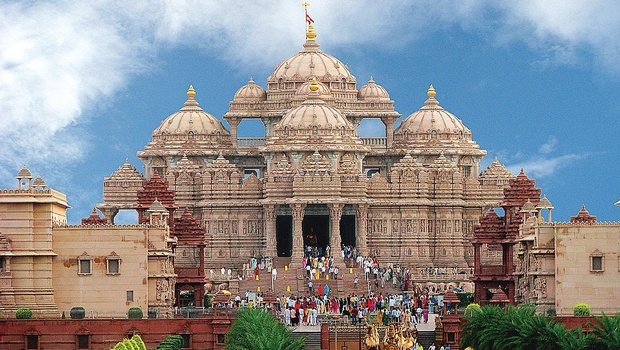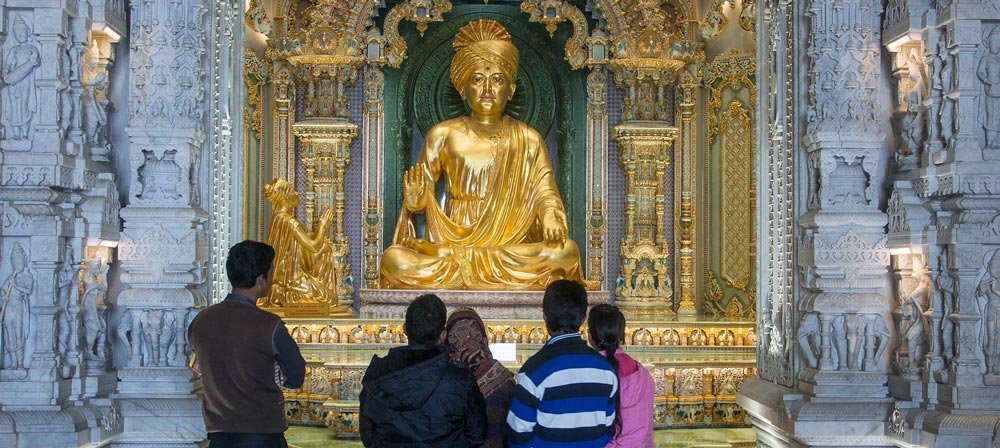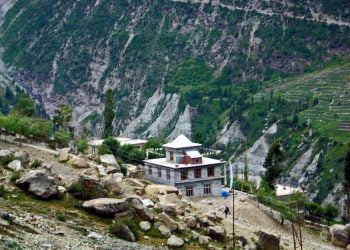Akshardham or Swaminarayan Akshardham complex is a Hindu mandir, and a spiritual-cultural campus in New Delhi, India. Also referred to as Delhi Akshardham or Swaminarayan Akshardham, the complex displays millennia of traditional Hindu and Indian culture, spirituality, and architecture. The temple, which attracts approximately 70 percent of all tourists who visit Delhi, was officially opened on 6 November 2005 by Dr A.P.J. Abdul Kalam. It sits near the banks of the Yamuna adjacent to the 2010 Commonwealth Games village in eastern New Delhi. The temple, at the centre of the complex, was built according to the Vastu Shastra and Pancharatra Shastra.
Shrine’s History
One of the most popular and amazing tourist attractions in the Indian nation is Akshardham temple. Known for its beauty and wide area Akshardham has several attributes that defines the existence and motive of human. Destiny of humankind along with universe details comprises the history of Akshardham temple. Researchers do not call this place only as temple as it is the place of enlightenment, education and entertainment.
The entire area of Akshardham spreads over 23 acres and it includes parks, rides, lakes, sculptures and shrines flooded over the complete area of temple. All these things collectively describe the entire experience of Indias rich heritage and culture. Akshardham temple history devotes its existence to Lord Swaminarayan and has its inspiration from Pujya Pramukh Swami Maharaj. Thousands of people and volunteers have invested their money and service to establish this miraculous architecture of Akshardham that explores the rich culture of religion.
The followers of Lord Swaminarayan work over here by spreading and enhancing the flavour of spirituality and devotion with complete peace of mind. This monument based on authentic and modern techniques present the perfect impression or imprint of Indian architecture with religious culture. The architecture comprises of pink sandstone that comes from Rajasthan. More than thousands of these exclusive stones are carved with historical imprints that narrate the rich culture of India through pictures and carvings. The artists and builders have not used cement or metals like steel so that monument lives for years to come. The history of Akshardham temple suggests that there are about 93 pillars that are sculpted and more than 40 windows having to carve from either side that allows patterns to look outstanding.
The carving done on pillars and the walls of the temple are actually poetic and looks wonderful in narrating the aura of devotion towards the culture. This particular temple has its name in the book of records in the world, Guinness and it includes all the basic amenities and features that allow offering a prayer. Akshardham Temple history is available on stores and the internet for the people having the interest in this religious monument.
The temple does not ask you to follow particular God rather it just asks people to pray their mentor or teacher that is to whom they owe their existence. All these theories by Lord Swaminarayan were compiled together and the place called Akshardham came into origin. People here come to practice self-peace of mind and soul as per historical aim of this temple


Architectural Relevance of This Shrine
The main attraction of the Swaminarayan Akshardham complex is the Akshardham Mandir. It rises 141-foot (43 m) high, spans 316-foot (96 m) wide, and extends 356-foot (109 m) long. It is intricately carved with flora, fauna, dancers, musicians, and deities. Designed in accordance with the standards of Maharishi Vastu Architecture, it features a blend of architectural styles across
India. It is entirely constructed from Rajasthani pink sandstone and Italian Carrara marble. Based on traditional Hindu architectural guidelines (Shilpa Shastras) on maximum temple life span, it makes no use of ferrous metal. Thus, it has no support from steel or concrete. The mandir also consists of 234 ornately carved pillars, nine domes, and 20,000 murtis of sadhus, devotees, and acharyas. The mandir also features the Gajendra Pith at its base, a plinth paying tribute to the elephant for its importance in Hindu culture and India’s history. It contains 148 life-sized elephants in total weighing a total of 3000 tonnes.
Under the temple’s central dome lies the 11-foot (3.4m) high murti of Swaminarayan seated in abhayamudra to whom the temple is dedicated. Swaminarayan is surrounded by images of the faith’s lineage of Gurus depicted either in a devotional posture or in a posture of service. Each murti is made of paanch dhaatu or five metals in accordance with Hindu tradition. The temple also houses the murtis of Sita Ram, Radha Krishna, Shiv Parvati, and Lakshmi Narayan.
Shrine’s Map Location and How to Go There
By Rail
FROM NEW DELHI RAILWAY STATION (40 MINS)(11KM) FROM OLD DELHI RAILWAY STATION (45 MINS)(10KM) Hazrat Nizamuddin (NZM) – 6 Km Neareet Metro Station is Akshardham Metro – 350 meters (walk)
By Air
Indira Gandhi International Airport (DEL) – 21 Km
Shrine Timings
Tuesday to Sunday First Entry: 9:30am Last Entry: 6:30pm CLOSED: EVERY MONDAY
Extra Information About this Shrine
Tickets for various shows held here are sold between 10:00am to 5:00pm













































